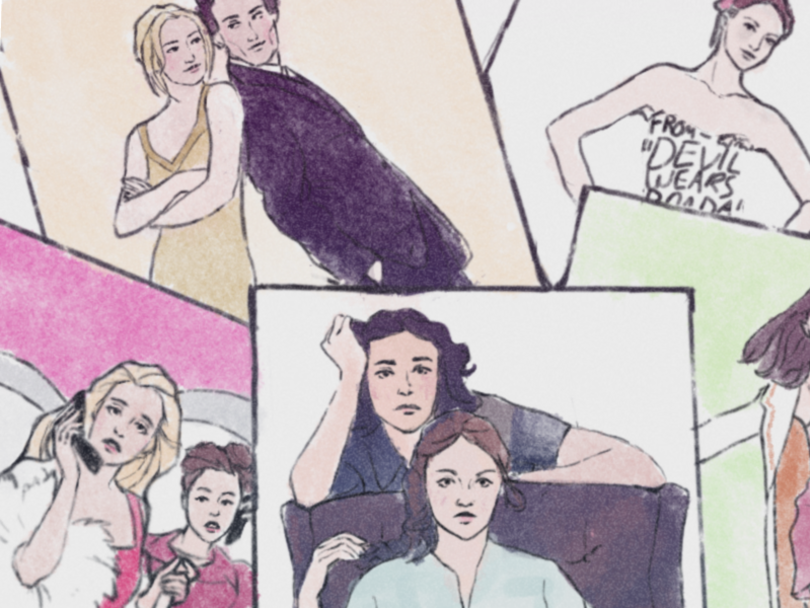The box office is due for a rom-com comeback, diverse representation

Leah Bowman | Contributing illustrator
It’s time for Hollywood to develop rom-coms that feature minority actors as leads and represent diverse storylines, our columnist argues. People deserve to enjoy films where they feel represented.
Get the latest Syracuse news delivered right to your inbox.
Subscribe to our newsletter here.
As Valentine’s Day approaches, many people, myself included, log on to Netflix in search of their favorite romantic comedies for a little escapism — the ones where Julia Roberts, Drew Barrymore or Kate Hudson live in a luxurious New York City apartment and work a glamorous job at a magazine or in a law firm. Looking at their life, they seem to have it all. The only thing missing is their Hugh Grant, Adam Sandler or Matthew McConaughey to sweep them off their feet.
Throughout the 1990s, 2000s and early 2010s, rom-coms dominated the box office. Movies like “My Big Fat Greek Wedding,” “The Proposal” and “Pretty Woman” were acclaimed, high-grossing blockbusters that people of all ages flocked to theaters to go see.
This is in part because watching throwback rom-coms is a stress-free and easygoing viewing experience. They’re somewhat cliche yet still charming, allowing audiences to cry and feel joy all at once. A major part of the rom-com’s initial success is its ability to tackle crucial parts of the human experience: love and heartbreak.
Since the 20th century, many rom-coms have mimicked the works of William Shakspeare, whose pieces were targeted to broad audiences making them universally loved. According to Neuroscientist Aditi Subramaniam, one of the defining features of rom-coms is their comfort and familiarity: viewers can both “escape” the realities of their own romantic lives and experience what feels familiar during times that might feel the opposite.
“They’re also comforting,” Syracuse University junior Camille Rowlands-Rees says. “They don’t need to be deep but there’s still romance, and then a conflict but there’s always a happy ending.”
Despite their popularity, the rom-com genre has seemed to die out in mainstream media. The last rom-com to perform incredibly well in the box office was “Bridget Jones’s Baby” in 2016. Since then, most rom-coms are only released on streaming services.
Movies like “The Lovebirds,” “Happiest Season” and “Always Be My Maybe” saw success on streaming services but failed to receive the critical acclaim of many rom-coms of the past. These movies, which told the stories of underrepresented groups in Hollywood, have earned high reviews on sites like Rotten Tomatoes and Letterboxd.

Cindy Zhang | Digital Design Director
But this same representation is not often seen in the movies that get released into the theaters. Most popular rom-coms star white, middle class, heterosexual characters, leaving characters of various underrepresented groups to take on background roles. And often, they are absent from the story completely. As society progresses in terms of diversity, the push for more inclusive stories within Hollywood, including romantic ones, must progress as well.
Recently, 2023 rom-com, “Anyone But You” starring Sydney Sweeney and Glen Powell, performed well in the box office. Many took to X, formerly known as Twitter, and TikTok to express their love for the movie and the genre as a whole — Reddit pages were filled with the hopes of a rom-com comeback. People also praised the movie for its take on intimacy while still providing a similar humor to their nostalgic favorites.
The movie tells the story of the romance between two white, heterosexual characters: Bea (Sweeney), a law student, and Ben (Powell), a wealthy Goldman Sachs employee. But a good portion of the film focuses on a queer interracial couple played by Alexandra Shipp and Hadley Robinson.
The box office and online success of “Anyone But You” proves people still love and want more from the genre, but many viewers want movies that tell inclusive stories where characters that remind them of themselves are not side characters or in the background.
SU senior, Ashtha Singh, says, “I don’t see myself as the target audience for them. As a woman of color, I rarely see girls of color as love interests.”
According to UCLA’s 2022 Hollywood Diversity Report, amongst all movie genres, only 2.2 out of every 10 lead actors are people of color. For leads with disabilities or queer leads it’s even less, but it has proven that “films with diverse casts continued to outperform their less-diverse counterparts.”
“If we’re not seeing marginalized groups at the center of them, it feels as if we’re saying their love stories aren’t worth portraying,” Singh said. “There’s a ton of potential for the new age of rom-coms and I’d hate for this new age to continue leaving out groups that often don’t get the chance to feel romanticized.”
If movies highlighting diversity and promoting inclusivity are there, the audience will follow.
It’s clear that people’s appreciation for rom-coms hasn’t died out, unlike the genre itself. But, audiences simply want more diverse and inclusive stories.
Hollywood directors and writers need to develop films featuring stories that those watching can relate to you and feel represented in. People of all backgrounds deserve to enjoy rom-coms with characters that represent them and their life experiences, making them feel as if “meet-cutes” and love are attainable for everyone, not just the Jennifer Garners and Mark Ruffalos.
Kaitlyn Paige is a junior studying Public Relations. Her column appears bi-weekly, and she can be reached at kipaige@syr.edu.





